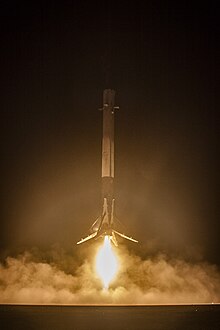Top Breakthroughs in 2017
Twenty Seventeen has been the most successful year for the innovations and breakthroughs. The year had many discoveries, with major advancements coming in numerous areas. Here, we have presented five significant breakthroughs announced in 2017 in five major fields.
SpaceX Reusable Launch System
(Space Exploration)
 The SpaceX reusable launch system development program is a privately funded program to develop a set of new technologies for an orbital launch system that may be reused many times in a manner similar to the reusability of aircraft. The company SpaceX is developing the technologies over a number of years to facilitate full and rapid reusability of space launch vehicles. The project’s long-term objectives include returning a launch vehicle first stage to the launch site in minutes and to return the second stage to the launch pad following orbital realignment with the launch site and atmospheric reentry in up to 24 hours. SpaceX’s long-term goal is that both stages of their orbital launch vehicle will be designed to allow reuse a few hours after return.
The SpaceX reusable launch system development program is a privately funded program to develop a set of new technologies for an orbital launch system that may be reused many times in a manner similar to the reusability of aircraft. The company SpaceX is developing the technologies over a number of years to facilitate full and rapid reusability of space launch vehicles. The project’s long-term objectives include returning a launch vehicle first stage to the launch site in minutes and to return the second stage to the launch pad following orbital realignment with the launch site and atmospheric reentry in up to 24 hours. SpaceX’s long-term goal is that both stages of their orbital launch vehicle will be designed to allow reuse a few hours after return.
The Quantum Computers
(Computing)

The development of actual quantum computers is still in its infancy, but experiments have been carried out in which quantum computational operations were executed on a very small number of quantum bits. Both practical and theoretical research continues, and many national governments and military agencies are funding quantum computing research in additional effort to develop quantum computers for civilian, business, trade, environmental and national security purposes, such as cryptanalysis. A small 16-qubit quantum computer exists and is available for hobbyists to experiment with via the IBM quantum experience project. Along with the IBM computer, a company called D-Wave has also been developing their own version of a quantum computer that uses a process called annealing.
See: Breakthrough: IBM Just Announced 50-qubit Computer
Artificial Womb
(Health)
An artificial uterus (or artificial womb) is a hypothetical device that would allow for extracorporeal pregnancy or extrauterine fetal incubation by growing an embryo or fetus outside the body of an organism that would normally internally carry the embryo or fetus to term. To date, no artificial uterus or incubator has yet given rise to the birth of an organism. This can potentially be performed as a switch from a natural uterus to an artificial uterus, thereby moving the threshold of fetal viability to a much earlier stage of pregnancy. In this sense, it can be regarded as a neonatal incubator with very extended functions. Also, it can potentially be used for initiation of fetal development.
Furthermore, it could avail for performing, for example, fetal surgery procedures at an early stage instead of having to postpone them until the term of pregnancy. A study published in 2017 described a working system used to successfully allow lamb fetuses (simulating premature babies) to continue to develop normally. See The Guardians for the news.
Plant-Based Meat
(Food)

Beyond Meat develops and manufactures a variety of plant protein-based food products. The vegetarian meat substitutes are made from mixtures of soy protein, pea protein isolates, yeast, and other ingredients. The company’s product offerings consisted of Beyond Chicken and Beyond Beef. A vegan and soy-free burger patty, called The Beast, was released in 2015. Beyond Meat products are available for purchase in packaged form as well as in retail-prepared dishes.
This year, though, Beyond Meat made that dream a reality by expanding the footprint of its plant-based (and not frozen) burger patties into meat sections at stores such as Safeway, Kroger, Wegmans, and Albertsons. It may not seem like a big deal to get out of speciality aisles, but it’s a sign that these products are actually good, and that the doors are opening wide for disruption in the meat industry. — Chase Purdy
Automated Driving
(Transportation)
Experiments have been conducted on automating driving since at least the 1920s; promising trials took place in the 1950s. The first truly autonomous prototype cars appeared in the 1980s and ALV projects in 1984 and EUREKA Prometheus Project in 1987. Since then, numerous companies and research organizations have developed prototypes. In 2015, the US states of Nevada, Florida, California, Virginia, and Michigan, together with Washington, D.C. allowed the testing of a utonomous cars on public roads.
utonomous cars on public roads.
In 2017 Audi stated that its latest A8 would be autonomous at up to speeds of 60 km/h using its “Audi AI”. The driver would not have to do safety checks such as frequently gripping the steering wheel. The Audi A8 was claimed to be the first production car to reach level 3 autonomous driving and Audi would be the first manufacturer to use laser scanners in addition to cameras and ultrasonic sensors for their system.
On the 7th November 2017, Waymo announced that it had begun testing driverless cars without a safety driver at the driver position, however; there is still an employee in the car.
See Electric Flying Cars Set To Take Place Skies.
This is all for now.
CyberSanchar wishes you all Happy New Year 2018.
Stay Hungry, Stay Foolish.




